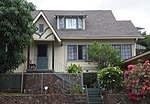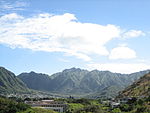Broken Ridge Buddhist Temple
1975 establishments in HawaiiBuddhist temples in HawaiiHawaiian architectureInfobox religious building with unknown affiliationKorean-American culture in Hawaii
Broken Ridge Buddhist Temple (Korean: 무량사; Hanja: 無量寺; RR: Muryangsa) is a Korean Buddhist temple on the island of Oahu in the U.S. state of Hawaii. Originally known as the "Dae Won Sa Temple," it was constructed on King St in Honolulu in 1975. After being destroyed by fire, construction of the new temple located in the Palolo Valley began in 1986. Due to legal disputes construction was not completed until 2005.
Excerpt from the Wikipedia article Broken Ridge Buddhist Temple (License: CC BY-SA 3.0, Authors).Broken Ridge Buddhist Temple
Halelaau Place, East Honolulu Maunalani Heights
Geographical coordinates (GPS) Address Nearby Places Show on map
Geographical coordinates (GPS)
| Latitude | Longitude |
|---|---|
| N 21.305076 ° | E -157.782651 ° |
Address
Halelaau Place 2430
96816 East Honolulu, Maunalani Heights
Hawaii, United States
Open on Google Maps






